In the sprawling digital marketplace, consumers are tired. They are fatigued by a relentless barrage of sponsored posts, intrusive pop-ups, and ads that scream for attention but offer little value. This has created a significant trust deficit, forcing brands in the digital marketing USA landscape and beyond to seek authentic engagement in an increasingly noisy, pay-to-win world. Now, a seismic shift is underway, led by OpenAI’s groundbreaking vision for monetization.
Table of Contents
The ChatGPT advertising model is not just another platform; it represents a fundamental overhaul of the relationship between businesses, technology, and consumers. It champions a future where value, relevance, and trust are the currencies that matter most. This article explores the depths of this trust-first, transaction-based ad platform, dissecting how it works, analyzing the data driving this monumental change, and providing a strategic playbook for marketers to thrive in the new era of conversational commerce and AI in digital marketing.
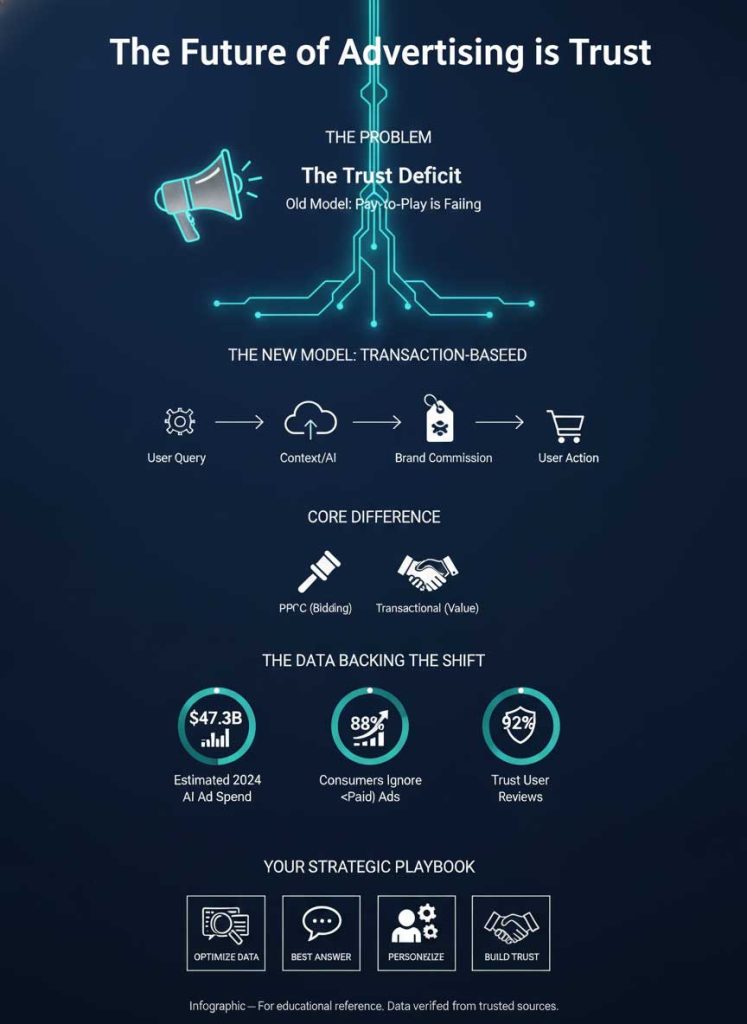
The Trust Deficit: Why the Pay-to-Play Ad Model Is Failing Modern Consumers
For years, the digital advertising ecosystem has been built on a simple premise: visibility is for sale. This pay-to-play ad model, perfected by tech giants, has generated trillions in revenue but has come at a steep cost to consumer confidence. When the top search result is simply the one with the biggest budget, users learn to be skeptical.
The Psychology of Ad Blindness and Banner Fatigue
Modern consumers have developed a sophisticated, subconscious ability to ignore anything that looks like an advertisement. This phenomenon, known as “ad blindness,” is a direct response to oversaturation. Users’ eyes automatically skip over banners and sponsored content sections, rendering countless ad dollars ineffective.
This defensive mechanism is backed by data. Recent reports show that over 42% of internet users worldwide employ ad blockers, with penetration rates in the USA steadily climbing. This isn’t just about avoiding annoyance; it’s a clear signal that the old way of interrupting users is no longer welcome. The demand for a value exchange has never been higher.
How the Pay-to-Play Ad Model Erodes User Trust in Advertising
The core issue with auction-based systems is the inherent conflict of interest. The platform is financially incentivized to serve the highest bidder, an incentive that may not align with the user’s goal of finding the best possible answer or product. This creates a credibility gap that has a lasting impact on brand perception.

Every time a user clicks a sponsored link only to find an irrelevant or low-quality landing page, a small piece of trust is eroded. Over time, this erosion damages the entire ecosystem. It’s this fundamental flaw that makes the search for Google Ads alternatives more urgent than ever and paves the way for a new model built on genuine utility and brand trust and loyalty.
Deconstructing the ChatGPT Advertising Model: A Revolution in Conversational Commerce
The OpenAI ad strategy represents a radical departure from the status quo. Instead of selling ad space, it aims to facilitate valuable outcomes, creating a system where the platform, the user, and the brand are all aligned toward the same goal: a successful transaction.
Core Concept: What Is a Transaction-Based Ad Platform?
A transaction-based ad platform operates on a simple, powerful principle: brands only pay when they get a tangible result. There are no charges for impressions or clicks. Instead, a brand pays a pre-determined commission or fee after a user completes a desired action—like purchasing a product, booking a hotel, or signing up for a service directly through the interface.
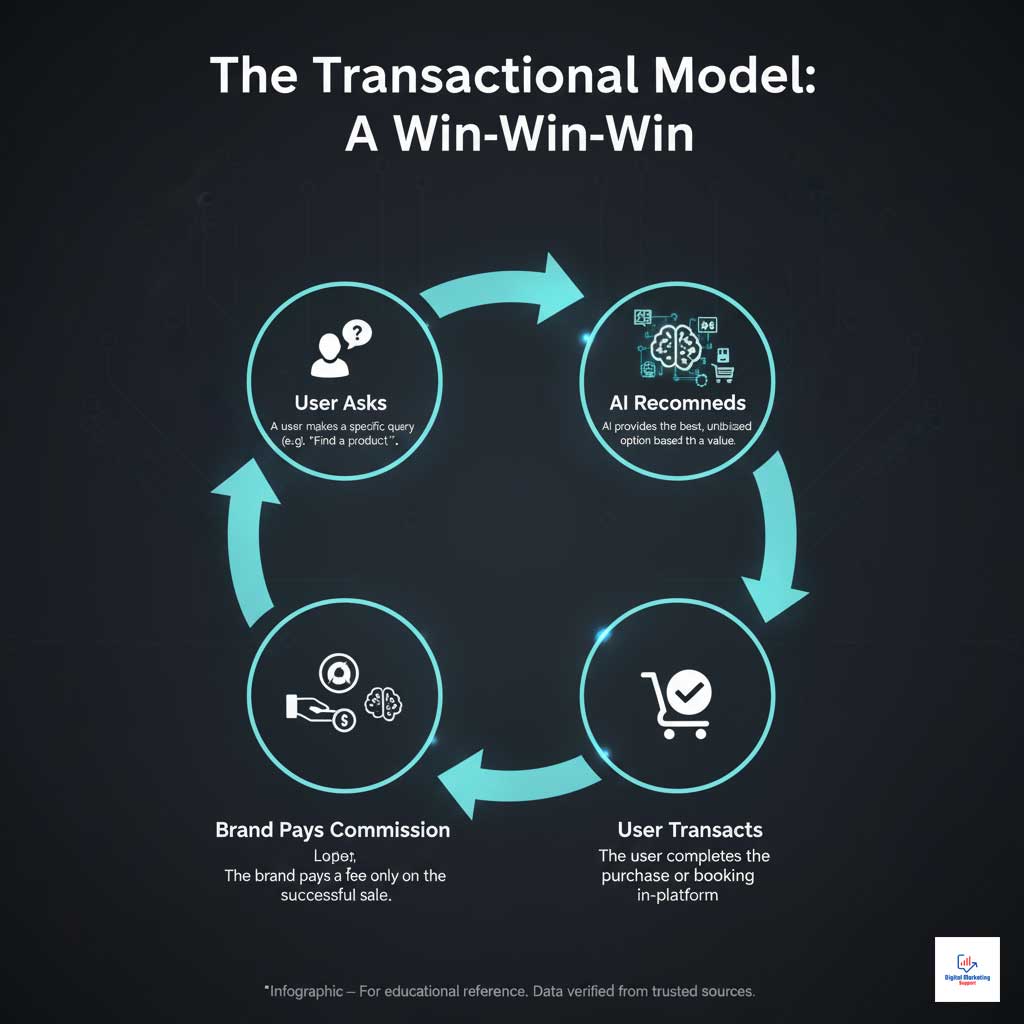
This model is inherently more efficient and less risky for advertisers. More importantly, it completely realigns the platform’s incentives. To maximize its own revenue, the AI must provide the most helpful, accurate, and compelling recommendations to ensure the user follows through with a transaction. This is a core tenet of the ChatGPT advertising model.
How OpenAI’s Ad Strategy Builds and Preserves User Trust
Sam Altman, OpenAI’s CEO, has been clear that the platform will not be cluttered with traditional display ads. The strategy is centered on maintaining a clean, user-focused experience. This approach to how is user trust preserved in AI-powered advertising? is built on several key pillars:
- Merit-Based Recommendations: The AI’s suggestions are based on quality, relevance, user reviews, and value—not on a hidden bidding process.
- Seamless Integration: Recommendations are a natural part of the conversation, not a jarring interruption.
- Full Transparency: This model fosters ad transparency by rewarding the best solution, making the interaction feel more like consulting a trusted expert than browsing a billboard.
Imagine asking, “Find me the best noise-canceling headphones for air travel under $300.” The ChatGPT advertising model would analyze product specs, expert reviews, and user feedback to recommend the best option, facilitating the purchase right in the chat. The headphone brand pays a commission only after the sale is complete, ensuring the recommendation was genuinely helpful.
The Rise of the Conversational Search Engine
This trust-centric approach is transforming chatbots from simple Q&A tools into sophisticated advisors. ChatGPT is evolving into a conversational search engine—a platform where users don’t just find links but get complete answers and accomplish tasks.
This shift marks the next phase of conversational commerce, where the entire customer journey, from discovery to purchase, happens within a single, seamless dialogue. For brands, this means being the best answer is no longer just good SEO; it’s the entire business model.
ChatGPT Ads vs. Google Ads: A Head-to-Head Comparison for 2025
For marketers planning their future strategies, understanding the fundamental differences between these two powerful platforms is critical. Answering the question, what makes ChatGPT ads different from Google Ads in 2025?, reveals two diverging philosophies on the future of digital discovery and advertising.
While Google has long been the undisputed king of search advertising, the ChatGPT advertising model presents a compelling alternative built for a new generation of users who demand authenticity and immediate value.
| Feature | Google Ads (Traditional PPC Model) | ChatGPT Advertising Model (Transactional) |
| Core Philosophy | Bid for visibility (Pay-to-Play) | Earn visibility through value (Perform-to-Play) |
| Payment Trigger | User clicks an ad (Pay-Per-Click) | User completes a purchase/booking (Pay-Per-Transaction) |
| Primary Goal | Drive traffic and leads to a brand’s website. | Facilitate a completed transaction within the conversation. |
| User Experience | Interruptive; ads are clearly labeled and separated. | Seamless; recommendations are woven into the natural flow of dialogue. |
| Measurement of Success | CTR, CPC, Conversion Rate (on an external site). | Direct ROI; ad spend is a direct percentage of revenue generated. |
| Brand Ranking Factor | Ad budget, Quality Score, keyword relevance. | Product quality, user reviews, pricing, conversion-friendliness. |
| Trust & Transparency | Moderate; users know they are clicking on a paid placement. | High; recommendations are perceived as organic and unbiased. |
| Best For | Top-of-funnel awareness, lead generation, website traffic. | Bottom-of-funnel conversions, direct sales, high-intent queries. |
The Data Driving the Shift: AI Marketing Statistics & Projections for 2025–2028
The strategic pivot toward AI in digital marketing is not based on speculation; it is a calculated response to overwhelming market data. The industry is not just adopting AI—it is restructuring itself around AI’s capabilities, with budgets and strategies reflecting this new reality. The latest AI marketing statistics 2025 paint a clear picture of an industry in transformation.
Unpacking the Investment Surge in AI Marketing
The financial commitment to AI marketing is staggering. Global spending is projected to explode from approximately
35billionin2024to∗∗35billionin2024to∗∗47.3 billion in 2025**, on a trajectory to surpass $107 billion by 2028. This isn’t just incremental growth; it’s an exponential expansion.
This investment is a strong indicator of where the industry is headed. Furthermore, a recent survey revealed that 92% of brands plan to actively invest in generative AI in marketing initiatives by 2028. This signals a long-term commitment to integrating AI into the core of marketing operations, moving far beyond experimental phases.
The Human Element: How Marketers Are Already Using AI
This technological shift is already deeply embedded in the daily workflows of marketing professionals. An estimated 88% of marketers report using AI tools daily to streamline tasks, generate ideas, and analyze data. In the USA, between 42% and 55% of marketing departments have formally adopted generative AI in marketing tools. This demonstrates that AI in digital marketing is now a standard operational tool, not a novelty.

The table below summarizes the key adoption metrics and trends shaping the landscape.
| AI Marketing Adoption Metric (USA) | 2024 Status | 2025 Projection / Trend |
| AI Marketing Spend | ~$35 Billion | $47.3 Billion (Significant Y-o-Y Growth) |
| Primary Use Case | Content Creation & Automation | Hyper-Personalization & Campaign Optimization |
| Marketer Adoption Rate | ~80% experimenting or using | 88% integrated into daily workflows |
| Key Technology Focus | Predictive Analytics | Generative AI & Conversational Interfaces |
| Primary Challenge | Data Integration & Talent Gap | Ensuring Ethical Use & Proving ROI |
A Marketer’s Playbook: Actionable Strategies for Brand Visibility in Conversational Search
Adapting to the ChatGPT advertising model requires a strategic pivot away from bidding on keywords and toward becoming the most valuable and trustworthy answer. Here is a playbook for marketers to ensure their brands are ready for this new era of conversational commerce.
Foundational Step: Optimize Your Digital Presence for AI Crawlers
AI models like ChatGPT source their information from the vast expanse of the public web. To be recommended, your brand’s information must be structured, accurate, and easily digestible for machines.
H4: Implement Structured Data (Schema Markup)
Schema markup is a vocabulary of code that you add to your website to help search engines understand your content. Use it to explicitly define product details like price, availability, and user ratings. For a service business, define your offerings, service areas, and appointment-booking information. This makes you an ideal, low-risk data source for an AI.
H4: Maintain a Flawless Public Profile
Ensure your Google Business Profile, industry-specific directories, and other public listings are complete and consistently updated. Positive reviews, accurate operating hours, and a comprehensive description of services are critical data points an AI will use to assess your credibility.
Content Strategy for a Question-and-Answer World
Your content is no longer just for human readers; it’s a primary source for AI training and information retrieval. Your content strategy must evolve to serve this dual audience.

Instead of focusing solely on high-volume keywords, build a library of content that directly answers the detailed questions your customers are asking. Create in-depth FAQ pages, ultimate “how-to” guides, and unbiased product comparisons. This positions your brand as an authority and makes your content a prime candidate for AI to cite and recommend.
Mastering AI-Driven Personalization and Campaign Optimization
The future of marketing is personal. The brands that win will be those that use technology to deliver uniquely relevant experiences at scale. This is where personalization technology becomes a superpower.
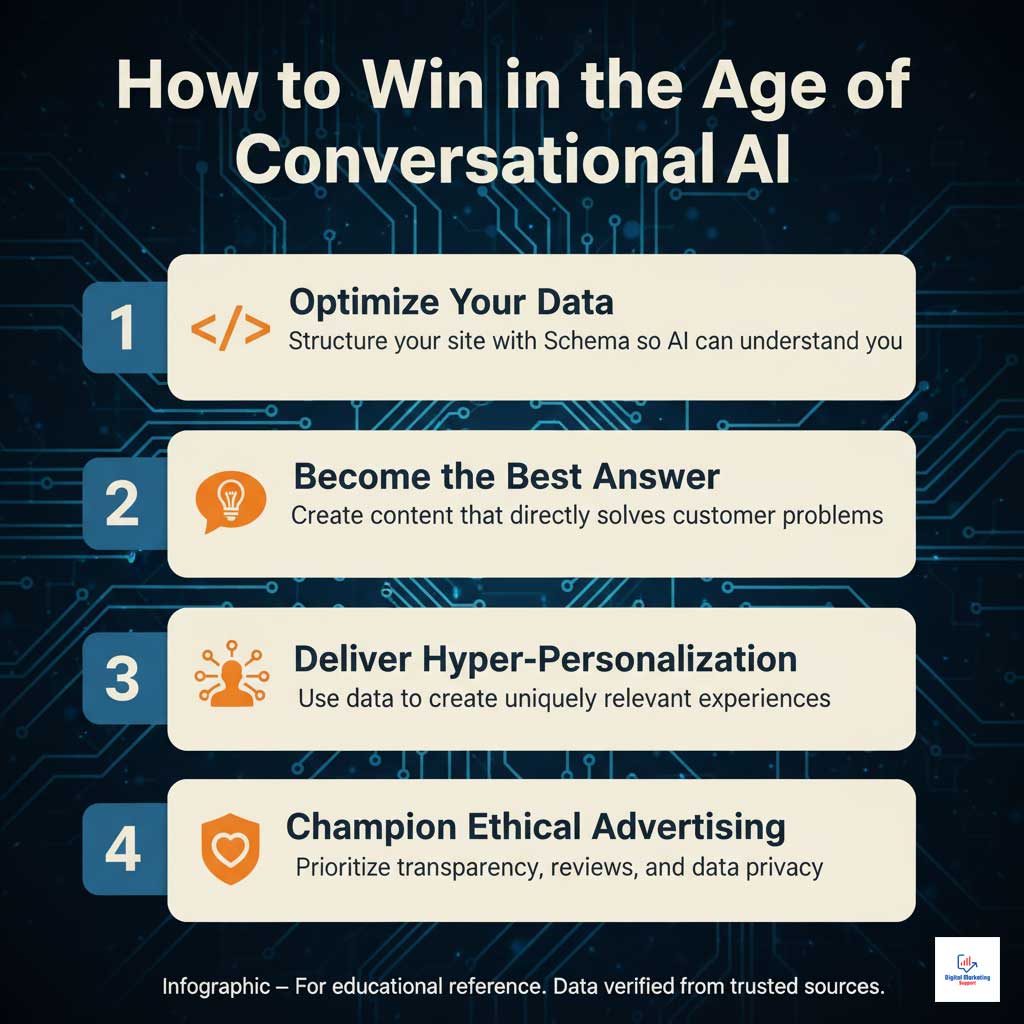
Leverage your first-party customer data to understand individual preferences and past behaviors. Use this intelligence to power AI-driven campaign optimization, tailoring offers, product recommendations, and communications. A brand that consistently demonstrates it understands a customer’s needs is far more likely to be recommended in a personalized, AI-driven conversation. This proactive use of AI in digital marketing builds a moat around your customer relationships.
Lean into Ethical Advertising and Build Brand Trust
In an ecosystem where trust is the ultimate metric, your brand’s reputation is everything. The OpenAI ad strategy inherently rewards businesses that operate with integrity and transparency. This is the new frontier of ethical advertising.
Be radically transparent about your pricing and policies. Actively solicit customer reviews and respond to both positive and negative feedback thoughtfully. Prioritize data privacy and give customers control over their information. These actions build the kind of brand trust and loyalty that cannot be purchased through ad spend, making you a natural fit for a trust-based advertising model.
The Real-World Impact: Case Studies and ROI in AI-Driven Advertising
While the full-fledged ChatGPT advertising model is still emerging, we can look at existing applications of conversational commerce and AI-powered personalization to understand its potential impact. The real-world impacts of conversational search on marketing ROI are already being demonstrated in various sectors.
Hypothetical Case Study: The Travel Industry
Consider two hotels in Miami. Hotel A has a massive advertising budget and consistently ranks at the top of traditional search ads. Hotel B has a smaller budget but boasts exceptional customer reviews, transparent pricing on its website, and a highly detailed online presence showcasing its unique amenities.
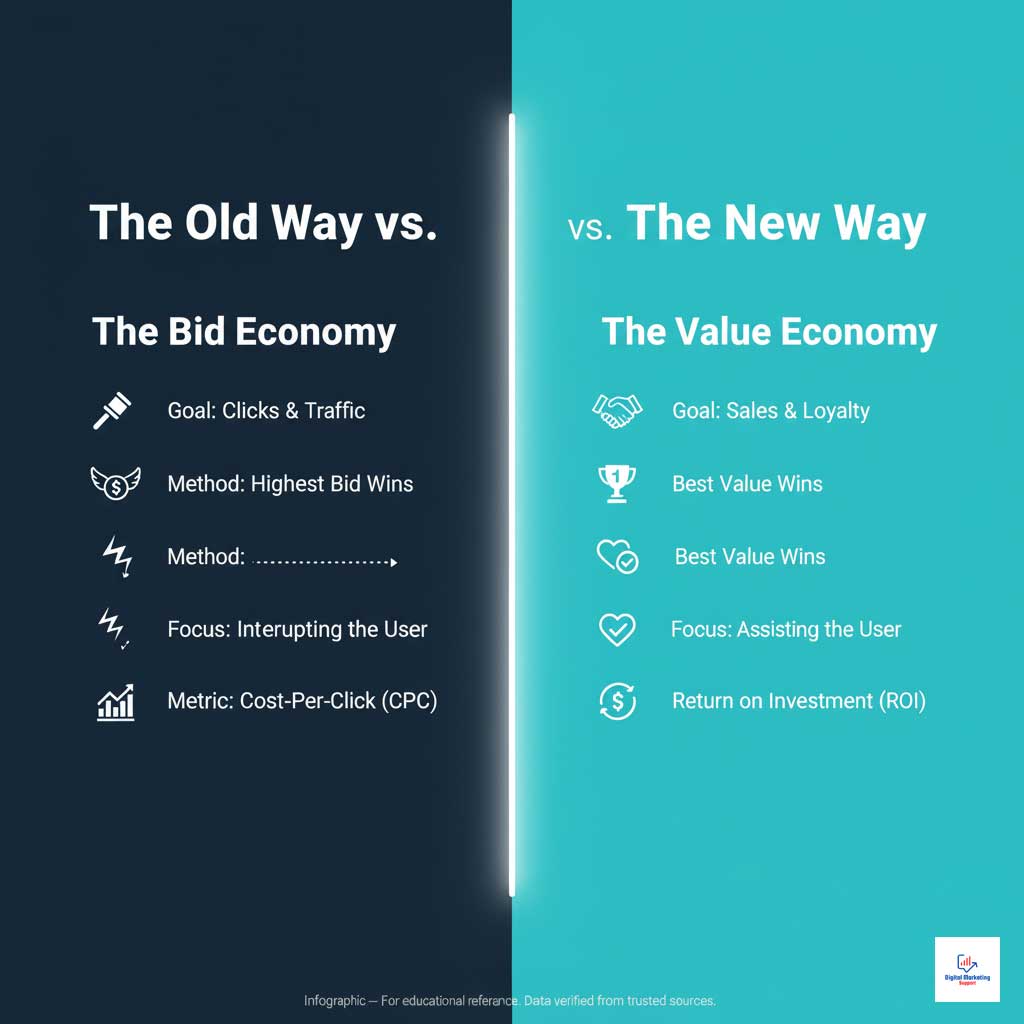
A user asks ChatGPT, “Find me a quiet, boutique hotel in Miami with a rooftop pool and great reviews for a romantic getaway.” The AI, optimizing for the user’s detailed request and prioritizing trust signals, recommends Hotel B. The user books directly through the conversation. Hotel B pays a small commission to OpenAI but acquires a perfectly matched customer at a fraction of the cost of a traditional campaign, while Hotel A’s ad budget was irrelevant. This is a prime example of the transaction-based ad platform in action.
Lessons from Early Conversational Commerce Platforms
Leading brands have already proven the effectiveness of this approach on a smaller scale. Case studies of AI-driven personalization in ad campaigns show significant uplifts in engagement and conversion.

For instance, Sephora’s chatbot on Kik allowed users to get personalized makeup tips and product recommendations. By making the discovery process conversational and fun, Sephora drove a significant increase in engagement and sales. Similarly, Domino’s “Dom the Pizza Bot” enables customers to order through Facebook Messenger, streamlining the process and boosting order frequency. These early successes prove that reducing friction and adding value within a conversation leads to better business outcomes.
Conclusion: Summary & Key Takeaways for the Future of Advertising
The digital advertising landscape is at a critical inflection point. The future is moving decisively away from the interruptive, pay-to-play ad model and toward an integrated, value-driven ecosystem. The ChatGPT advertising model is at the forefront of this revolution, built on a foundation that prioritizes user trust in advertising above all else.
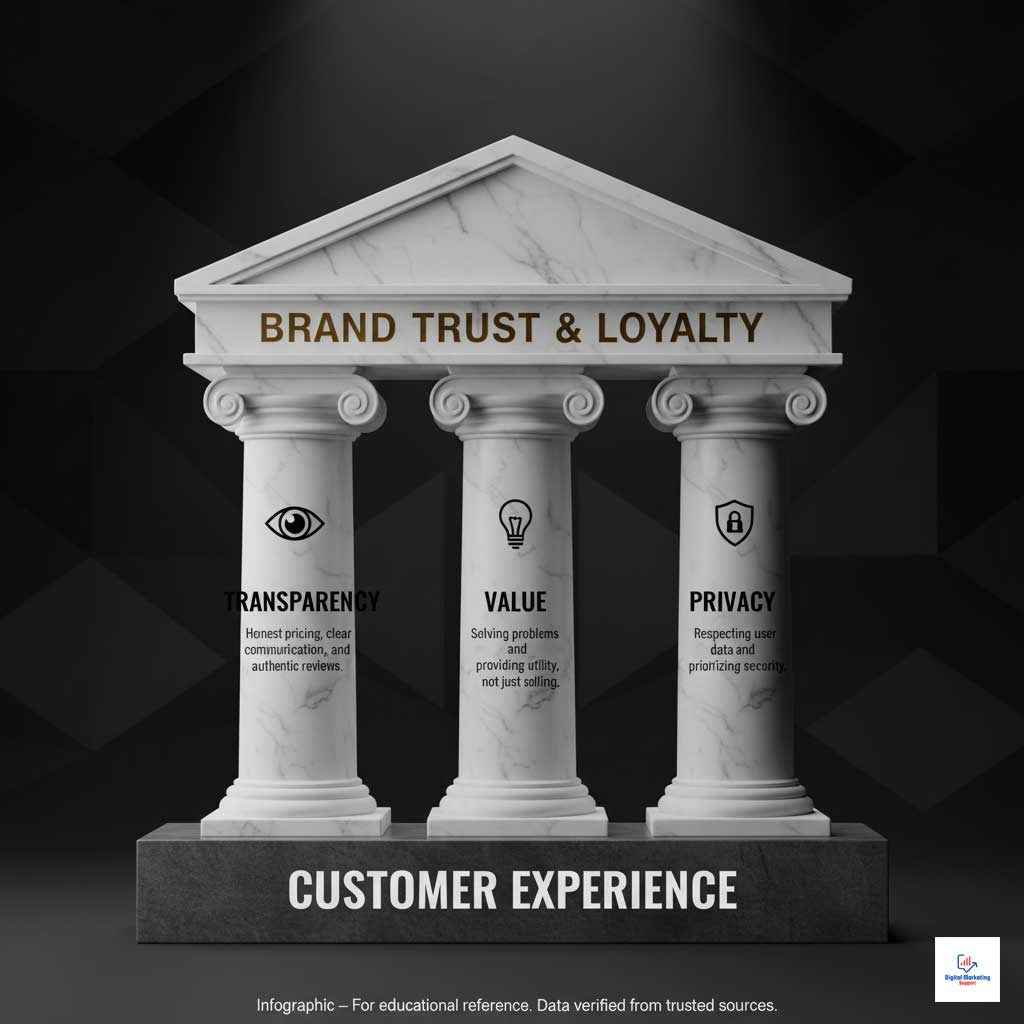
This paradigm shift makes the internet a more valuable resource for consumers and a more meritocratic playing field for businesses. The core takeaway for marketers is profound: stop focusing on how to buy attention and start focusing on how to be the best answer. This requires a deep investment in product quality, exceptional customer experience, and transparent, easily accessible data.
The brands that embrace this new philosophy of ethical advertising and master the art of conversational commerce will be the ones who build unbreakable brand trust and loyalty. They will not only survive in the era of AI in digital marketing—they will define it.
Frequently Asked Questions (FAQs)
How will ChatGPT ads change the digital marketing landscape in 2025?
The ChatGPT advertising model will shift the digital marketing focus from bidding for clicks (PPC) to earning conversions. This will compel brands to prioritize superior product quality, customer service, and data transparency, as AI recommendations will be based on merit and value, not ad spend.
Is OpenAI’s ad model safer and more trustworthy than Google Ads?
It is designed to be fundamentally more trustworthy. By adopting a transaction-based ad platform, the OpenAI ad strategy removes the financial bias of a bidding system. The AI is incentivized to provide the best recommendation to facilitate a transaction, which naturally aligns its interests with the user’s.
What are the top AI marketing trends in the USA for 2025?
The top trends include the widespread adoption of generative AI in marketing for content creation, the use of sophisticated personalization technology for hyper-relevant customer experiences, the growth of conversational commerce, and a strategic pivot towards performance-based, transaction-driven advertising models.
How can marketers leverage generative AI for campaign efficiency?
Marketers can use generative AI to automate the creation of ad copy, social media content, and email campaigns; analyze vast datasets to uncover performance insights for AI-driven campaign optimization; and generate personalized communications at a scale that was previously impossible.
Are transaction-based ad platforms the future of conversational commerce?
Yes, they are widely considered the future. This model provides brands with a clear, risk-free ROI (paying only for sales), while ensuring users receive high-quality, unbiased recommendations. This sustainable framework perfectly supports the trust-dependent nature of conversational commerce.
What ethical challenges does AI present in advertising?
The primary challenges in ethical advertising involving AI include ensuring data privacy, preventing algorithmic bias that may unfairly favor certain products or demographics, and maintaining ad transparency so users understand when and how AI is influencing the information they receive.
How do Google Ads and ChatGPT ads compare for brand ranking?
In Google Ads, brand ranking is heavily determined by ad budget (bids) and Quality Score. In the ChatGPT advertising model, “ranking” is a fluid concept based on the AI’s real-time assessment of which brand best fulfills a user’s specific, conversational query, prioritizing value over budget.
Will AI personalization boost customer loyalty in digital marketing?
Absolutely. When executed ethically, AI-driven personalization makes customers feel seen and understood. Delivering tailored recommendations and relevant content through advanced personalization technology significantly enhances the customer experience, which is a cornerstone of building lasting brand trust and loyalty.
What proof is there that conversational AI ads increase ROI?
While the model is new, early case studies of AI-driven personalization and chatbot commerce show that guiding users to solutions within a conversation increases conversion rates and order values. In a purely transactional model, the ROI is direct and undeniable, as ad spend is tied directly to revenue.
Can brands influence ChatGPT ad recommendations?
Brands cannot pay to influence recommendations directly. However, they can influence them indirectly and ethically by offering an excellent product, accumulating positive public reviews, maintaining competitive and transparent pricing, and ensuring their business data is well-structured and accessible online.
How does OpenAI’s ad strategy build user trust?
The OpenAI ad strategy builds trust by eliminating the core conflict of interest found in pay-per-click advertising. When users are confident that recommendations are organic and based on merit rather than financial bids, their trust in the platform and its suggestions naturally increases.
What is conversational commerce?
Conversational commerce refers to the practice of using technologies like chatbots, messaging apps, and AI assistants to interact with customers throughout their entire shopping journey. It allows brands to market, sell, and provide support within a single, seamless conversational interface.








